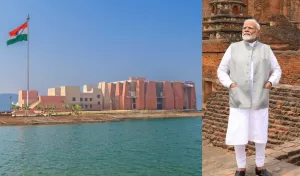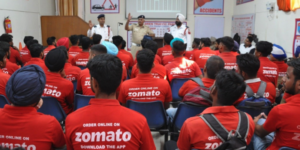In times of doubt and despair, remind yourself of a line from Pablo Neruda: “You can cut all the flowers, but you cannot keep Spring from coming”. The government has done everything to cut all communications. The roads have been blocked; trenches have been dug to prevent tractors from entering the city; beds of sharp nails have been laid out to injure and hurt intentionally those trying to cross the boundaries. Not only that, files of armed policemen are standing guard to watch out against the enemies, the enemies of the nation, described variously as ‘deshodrohis’, ‘andolonjivis’ and ‘parajivies’ by our leader .
And, on top of all that looms large the long shadow of the massive second wave of Covid-19 pandemic. It has been aggravated to no small extent by our opinionated leader who understands little but has faith in all the Hindu myths and rituals for fighting it. It is dangerous, but as one of the leaders of the farmers movement said, the three livelihood threatening farm laws are even more dangerous. Indeed, the farmers cannot afford to be intimidated.
Delhi feels like a besieged city where even news cannot travel across the border in this digital age. Only the Corona virus does. The obliging national media has seen to that. Let alone the official media, even the private media well-paid with advertisements from the government and corporate funds are sufficiently compromised. If they do not fall in line lured by lucrative advertisements, they are threatened with legal and tax harassments. Falling out of line is very costly both in terms of money and harassment from this regime. This democratically elected government feels duty bound to silence all dissidents, and those unpatriotic deshodrohis at the border. So fake news, and manufactured news, and propaganda are fed to the public to dry up support for the farmers, treated almost as hordes of terrorist enemies waiting at the border.
And yet, there is a paradox in such situations. Opposite political tendencies gradually build up almost in a dialectical development within a peoples’ movement, with action setting off reaction. The more the government tries to tighten its grip on dissent by cutting out all communications and shutting genuine dialogues, the more new ways of communication are invented by the farmers’ collective. As the circle of dissent widens, brutal severing of communications begins to create new bonds not visible before. It is a well known feature of social behavior that people act in greater solidarity to cope with disasters like earthquakes. Something like this seems to be happening. In this process, as difficulties are gradually overcome, what appeared impossible to achieve a while ago seems entirely possible now.
The immense power of solidarity that moves mountains to fight back the authoritarian imposition of state power materializes only when the traditional fault lines and divisions in the society begin to be overcome. Probably more than any other country in the world India has many such fault lines. It is customary to gloss over them under the slogan of ‘unity in diversity’ but actual power of a movement does not depend on such high sounding platitudes. Genuine solidarity is forged through wise handling of these diversities. The most remarkable thing about this farmers’ movement is its intuitive and non-doctrinaire understanding of this, perhaps more acutely than political parties. This is why it is different from movements of political parties. And, if this continues, it is likely to grow from strength to strength, perhaps even indicating a new direction for Indian politics. The coming of spring seems possible now, maybe inevitable.
Hindu society is a labyrinth of social divisions in terms of castes and sub-castes. The fact that the movement was spear headed originally mostly by Sikh farmers was an advantage from this point of view. Not only did it show that non-majoritarian politics has a future in this country, but more importantly Punjab has the highest proportion of scheduled castes ( nearly one-third) with a division between the small to large land owning Jat farmers and Dalits mostly constituting landless wage earners. Class and caste division coincide to a very large extent like elsewhere in India. As the farmers camped indefinitely on the border, the Gurudwara culture of ‘service to all’ like eating and working together broke the barrier to an extent. However this would have remained only symbolic, until the message began to percolate widely that the minimum support price (MSP) for agricultural produce through the public distribution system (PDS) as outlet for availability of food for the poor are two sides of the same food security system. A closer reading of the three laws makes clear how the government was determined to dismantle any such notion of food security system by refusing to legalise MSP, by making free private profiteering the inevitable outcome through deregulation of hoarding of essential commodities including processed food items (like rice) and allowing trading including electronic trading permissible anywhere without tax. A joke heard on the border says, the most preferred location is PMO as it would make the two Gujarati businessmen close to the prime minister feel more cozy.
Not surprisingly, the support base of the farmers for repealing the laws began to widen as it resonated also with Dalit landless and semi- landless agricultural workers. A dramatic expansion across India started taking place when the traditional ‘Khap’ panchayats of Haryana and UP that were the bastions of the upper caste opened up their doors as ‘mahapanchyats’ inviting all to join the meetings against the farm laws. Many people’s causes that were dormant for years, many disparate social movements that never captured the imagination of the people, and many mountains of differences are being crossed. New initiatives spring up to celebrate the innovative genius of the massive movement that continues to defeat stale official cunning and biased untruthful media reporting falsehood at every turn.
Along with jettisoning of the three farm laws, the doctrine of Manuvad, a main pillar of the Hindu Rashtra is beginning to crack. Women always played a huge role in agricultural operations. Now they began to join, and came driving tractors, in buses, walking and took leading positions in the struggle. Apart from traditional trade unions in industry, independent trade unions led by young worker-activists, some just released from the prison joined in. So did Muslim farmers especially in west U.P leaving behind recent memories of communal riots. Such solidarity has not been seen before, not even during the nationalist struggle led by Gandhi and Nehru. It reminds one of Bhagat Singh’s vision and, of the INA led by Shubhas Bose, two favorite photographs to be seen particularly in the Singhu border. As the movement takes an all India character Periyar and Babasaheb Ambedkar are also names that came to feature predominantly, breaking down the false division between revolutionary and reformist struggles. The farmers’ movement remains a scrupulously peaceful mass struggle in spite of all provocations and threats. Farmers’ leaders urged people not vote BJP. The election result in Bengal where women, many Dalits, and Muslims forged solidarity in voting and in doing so cutting across traditional fault lines have given a devastating blow to the arrogance of the Modi government. The havoc played by the second wave of Covid 19 due to utter callousness of the government towards human suffering in the interest of protecting business profit– the core of the so-called Gujarat model- was jettisoned in Kerala in a decisive victory in the election.
The war has not been won yet, and mobilization goes on, on both sides. Most opposition political parties have supported the movement of the farmers, but they remain peripheral. Until they make clear their perspective on agriculture, on land acquisition, and on rural development (this includes TMC in Bengal and CPM in Kerala) with a viable strategy for employment creation, their support can be no more than a temporary tactical alliance. On the other side are the proponents of Hindu Rashtra with their upper caste Bramhinism hidden under the guise of social service for the Dalits (by RSS) and weaponizing of hate politics. The binding glue of the Hindu Rashtra is the corporate interests and all the votes and political horse trading that money can buy. The government is slowly learning that money can’t buy everything nor can state power suppress all dissent. It cannot even win all elections. Its utter failure in handling this second wave of Covid 19 is leading to a surge in public anger. The fact is simple even in this age of propaganda. You can fool some people for some time but you cannot fool all the people for all time; you can suppress some dissent for some time but you cannot suppress all dissent for all time. There is limit to money and state power. The determined resilience of the movement of farmers is slowly proving it, and the ferocity of Covid 19 is like a thunder from the sky, announcing it loudly to all of us.
Many flowers may be cut, but Spring can no longer be prevented from coming.
(Amit Bhaduri was Professor Emeritus in JNU, Delhi. He resigned in protest in January, 2020 from JNU because the University Administration in connivance with Delhi police turned a blind eye to the hooliganism let loose by pro-BJP students in the campus. Now he is an independent writer and researcher.)




